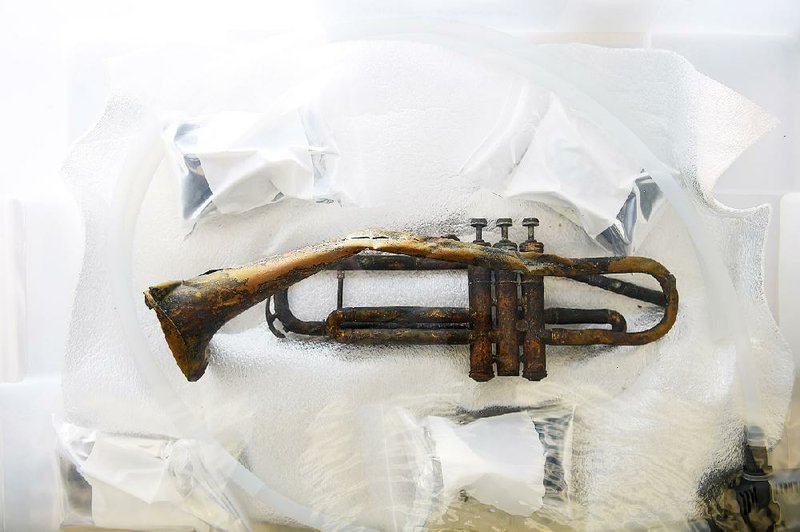The old, bent trumpet is dripping with water as Shanna Daniel lifts it from its basin in the conservation lab at the Washington Navy Yard.
It's a B-flat horn, made around 1934, with a bell that was smashed in battle, a missing mouthpiece, and brass tubing that is split and pitted.
Daniel, in a white lab coat and lavender rubber gloves, rests it on a layer of hard foam and lowers a magnifying light over it. She picks up a surgical scalpel and begins to scrape deposits from the surface.
She is very careful. The object has traveled a great distance, and sealed inside it may be the DNA of the sailor who played it.
The trumpet arrived at the lab 2½ years ago, handed over by an Australian diver who found it in the wreck of the USS Houston, a World War II cruiser, off the coast of Java in the southwest Pacific.
The Houston, which had been President Franklin D. Roosevelt's favorite vessel, was the elegant flagship of the Navy's Asiatic fleet when it was sunk in a fierce battle with the Japanese three months after the attack on Pearl Harbor.
Hundreds of sailors died as the Houston and the Australian cruiser HMAS Perth blundered into the Japanese warships at night and were illuminated by enemy searchlights.
The Allied ships fought valiantly. The Houston fired flares at the enemy when it ran out of ammunition. But the Japanese pounded away with guns and torpedoes. The Perth sank first, followed by the Houston shortly after midnight March 1, 1942.
About 650 U.S. sailors, including many members of the Houston's band, died.
Three hundred others survived and most spent the rest of the war in Japanese prison and labor camps.
The trumpet, battered in the "sinking event," as Navy senior conservator Kate Morrand put it, came to rest about 100 feet down, as the Houston settled on its starboard side in the murky waters outside Banten Bay, west of Jakarta, Indonesia.
Despite its condition and its decades on the bottom of the ocean, the instrument may hold clues to its owner, said Robert Neyland, head of the underwater archaeology branch of the Naval History and Heritage Command.
Conservators have found the trumpet's serial number, which helped track its date of manufacture by the C.G. Conn instrument company of Elkhart, Ind.
But they're hoping for more.
There is "the possibility of examining the interior of the [trumpet's] valves and potentially locating some DNA remains of the individual who played the trumpet," Morrand said in a recent interview at the Navy Yard.
It's a long shot, but the theory is that the owner may have left his DNA when he took it apart to clean it. And, sealed in when he reassembled it and then by seven decades of marine encrustation, the DNA may still be there, Morrand said.
"If we could recover DNA, and if there are descendants that we could match with ... [we could] identify who the owner of the trumpet was," Neyland said. "It kind of pushes the technology and pushes the science ... but it would be pretty exciting."
Survived February battle
On Feb. 4, 1942, electrician's mate Howard E. Brooks, 22, the son of a Tennessee tobacco farmer, was a member of a damage-control team near the Houston's rear turret when Japanese bombers appeared overhead. The Houston was steaming in the Flores Sea, north of Australia. As enemy bombs fell around the ship, Brooks was called to fix an ammunition hoist elsewhere on the vessel.
While he was away from his post, a 500-pound bomb struck near the turret, and when Brooks returned, he witnessed a scene of carnage. Scores of shipmates lay dead or dying. And the hulking turret, with its three huge guns, was askew and on fire. Inside, there was nothing left of the turret officer except his shoes and a hand still wearing a Naval Academy ring, according to a history of the ship.
"Oh, boy," Brooks, now 96 and one of the few living Houston survivors, said he thought to himself. "This is war. It came so quick."
It was nine weeks after Pearl Harbor, and the tide of Japanese conquest was sweeping across the Pacific.
In a recent interview at his home in Mount Laurel, N.J., Brooks said that when the attack ended, the Houston, damaged but seaworthy, steamed for the friendly port of Tjilatjap on the island of Java.
En route, the dead were collected, put in canvas bags and laid out on the fantail, he said. Once in port, the crew built coffins for the 48 men killed, a Houston officer, Walter G. Winslow, wrote later. And as the coffins were carried ashore, the ship's band played Chopin's funeral march.
Japan announced that the Houston had been sunk. The announcement was premature.
Diving in 2013
In the summer of 2013, Australian diver Frank Craven, 68, was diving with a group on the wrecks of the USS Houston and HMAS Perth. The ships were about 3 miles apart, near the mouth of Banten Bay.
The water was warm, the current was strong, and the divers had to pull themselves down on anchored ropes.
Visibility was poor. And Craven, a retired cattle rancher who lives north of Sydney, was an older, less-experienced diver. He thought he must be crazy. "Hardest dive of my life," he texted his son.
But his mother's first husband had been killed on the Perth. She had just died, and he wanted to leave a lock of her hair in the wreckage.
The next day, the divers went to the Houston, he said in an email.
The ship, which had hosted Roosevelt on four cruises in the 1930s, rested on its side. Its prow was broken off, and there were holes in its hull made by enemy torpedoes, according to a 2014 U.S. Navy survey of the wreck.
Remnants of its 60-foot-high foremast were present, as well as evidence of damage caused by Japanese shell fire. There were no visible human remains. But the ship's fuel oil was still leaking and drifting to the surface.
As Craven swam along the keel with an underwater flashlight, he noticed hundreds of ammunition shell casings, large and small. "What a battle they must have had," he said he thought.
Then, amid the shell casings and other wreckage of war, he spotted the trumpet.
He wondered: "Who would be playing a trumpet in the middle of a battle?"
He picked it up and took it to the surface, thinking he might somehow get it back to the United States.
Crippled and caught
By Feb. 28, 1942, the Houston and the Perth were two survivors of an Allied force of American, British, Dutch and Australian ships that had been decimated by the Japanese navy. Five allied ships were lost, along with more than 2,000 sailors.
The two were steaming under a full moon on a calm sea, headed west for the Sunda Strait, which separates Java from Sumatra, according to Winslow's account.
If they could get through, they might escape the Japanese onslaught and make for Australia. On the damaged Houston, only six of nine heavy guns were working. Both ships were low on fuel.
The Houston was at "condition 2," Brooks remembers. "You're not manning your guns, but you're sleeping by them." He was up on deck, under the guns of the rear turret, wearing only white skivvies, because of the hot night.
Suddenly, about 11:30 p.m., there were gun flashes from the Perth as it fired at an enemy vessel it had spotted. "That's what woke us all up," Brooks said.
"The next thing we knew, the whole sky lit up" with enemy flares, he said.
The battle of the Sunda Strait had begun.
The two Allied ships had stumbled into a huge enemy force that was landing troops in Banten Bay. The Houston and the Perth were virtually surrounded, assailed from all sides. Brooks said enemy vessels got so close that Japanese sailors could be seen on the decks.
The fighting lasted less than an hour, when about 12:10 a.m., the Perth was spotted sinking in the distance, Winslow, the Houston officer, recalled.
All enemy guns then trained on the Houston. "From that moment on ... we began a savage fight to the death," he wrote.
The Houston held its own for a time but was hit by three torpedoes. It slowed and began to sink. The captain ordered the crew to abandon ship.
Brooks grabbed a gray, kapok life jacket, and as the ship slowly rolled over, he clambered down the hull and jumped into the water.
"I wasn't scared," he said. "I wasn't frantic. I'm saying, 'Well, what do I do now?'" He reached a life raft filled with injured sailors and hung on. As they watched, he said, the sinking Houston was illuminated by enemy searchlights, its battle flag still flying from the rear mast, he said.
He couldn't recall whether anybody said anything when the ship sank. But he remembered how silently it went down.
Three years later, when Brooks and other prisoners of war were finally freed, their American liberators asked them: "Sailors? What ship were you on?"
The USS Houston.
"Never heard of it," he said the rescuers replied.
When the Houston sank, 11 members of its 18-man band went down with it, according to researcher Marlene Morris McCain, whose father, Edgar, played trombone and survived.
Those who perished included Severyn "Steve" Dymanowski of Gary, Ind., who played trumpet. Three others known to have played the trumpet survived the sinking, but they died in the 1960s and '70s.
The instrument Craven found may have belonged to one of those four.
A week after his dive, Craven emailed John Schwarz, head of the USS Houston CA-30 Survivors' Association and Next Generations, to say he had found the trumpet and wanted to give it to the association.
Schwarz, whose father, Otto, also was a Houston survivor, thanked Craven but said that the wreck remained the property of the Navy and that it was illegal to remove objects from it.
He told Craven to contact the Navy heritage command's underwater archaeology branch. Craven apologized for taking the instrument, reached a Navy attache in Australia and arranged for the transfer.
The trumpet was cushioned in bubble wrap and shipped to the Navy lab in Washington in November 2013, Morrand said.
The instrument was placed on a foam pillow in a tub of deionized water to start drawing out the corrosive salts eating at the metal.
One recent morning, Daniel hunched over the trumpet, scraping off corrosion with a No. 15 scalpel. The deposits came off as a fine green dust.
"We feel a lot of responsibility," Morrand said. "It went through a lot to get here. And we want to make sure ... it's going to stick around a lot longer."
SundayMonday on 02/07/2016

